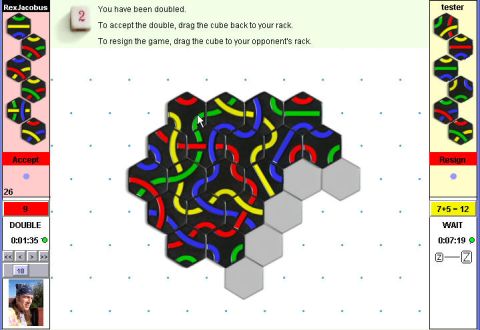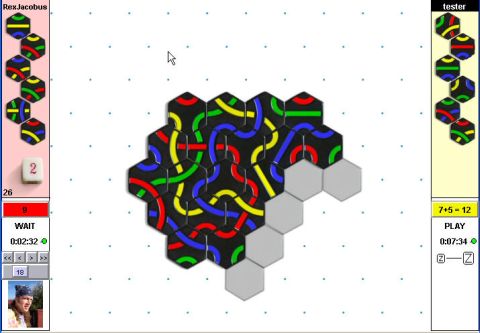|
What is a Cafe Room?
Aside from being a purveyor of fine coffee, the Cafe Room is where you go to play a quick game of Tantrix. Only the win or loss is counted, the margin of victory means nothing. This style of play suits cafes and casual table games. The strategy in a winner-take-all game can be very different. For example, big loop wins are not especially advantageous, in fact they can be a high risk strategy.
Cafe Games are designed to be played quickly - most games will finish in about 10 minutes. A player who can not win, should resign. If the doubling cube is used correctly, half of all games will finish early when a double is offered and dropped. Table tournaments have a time limit of 15 minutes rather than the standard 20 minutes.
Cafe Games can now be played online, but with a couple of twists!
- The Doubling Cube - We have borrowed the doubling cube concept from backgammon. Different to backgammon though, a double can be made at any time during your turn not just at the beginning. Also in Tantrix, doubling is limited to 8. In backagmmon there is often no limit.
- The Handicap - Players are given a handicap according to their expected winning margin. For example, a player with handicap of 4.1 is expected to beat a player with handicap 1.1 by an average of 3 tiles per game. In Cafe Games, your handicap is added to the other players score, so the expected outcome of a match between any two players is a draw.
The use of a doubling cube adds another strategic dimension to the game. When a game begins, the stakes are 1. At any point during the game, a player may use the cube to double the stakes. The opponent must then decide whether to pass, thereby conceding the game, or accept. A player who accepts now owns the cube. At any point in the game, the player who owns the cube may propose a redoubling of the stakes by turning it to the next higher number.
|
|




